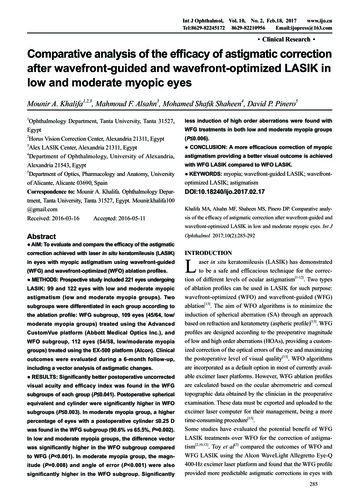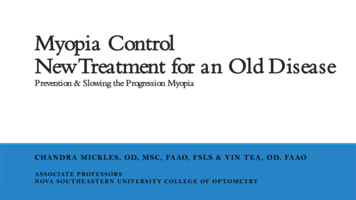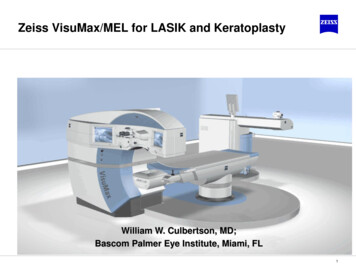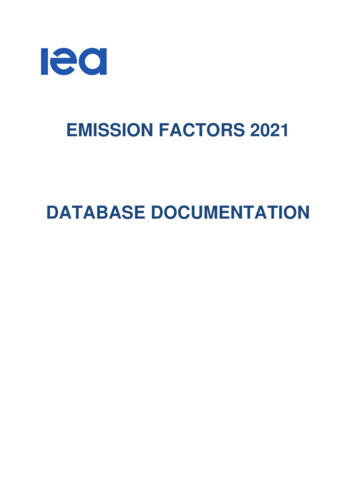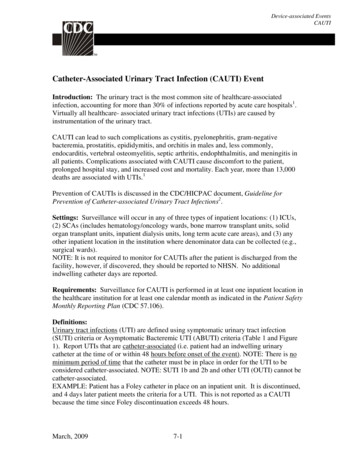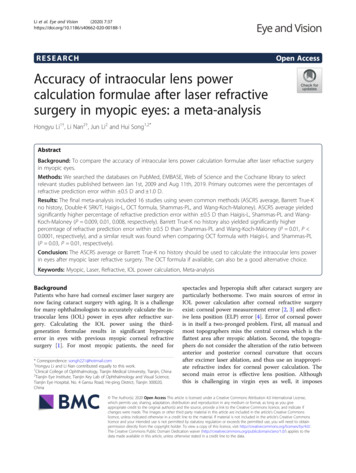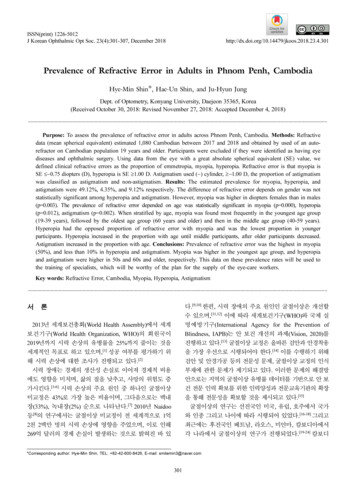
Transcription
Kim et al. BMC Ophthalmology(2020) ARCH ARTICLEOpen AccessFactors associated with myopia in Koreanchildren: Korea National Health andnutrition examination survey 2016–2017(KNHANES VII)Hyuna Kim1, Jin Seok Seo1, Woong-Sun Yoo1, Gyu-Nam Kim1, Rock Bum Kim3, Jae Eun Chae4, Inyoung Chung1,2,Seong-Wook Seo1,2 and Seong Jae Kim1,2*AbstractBackground: To evaluate the prevalence and risk factors associated with myopia and high myopia in children inSouth Korea.Methods: A total of 983 children 5–18 years of age who participated in the Korean National Health and NutritionExamination Survey 2016–2017 (KNHANES VII), a nationwide population-based cross-sectional study, were evaluated.Myopia and high myopia were defined as a spherical equivalent (SE) 0.5 diopters (D) and SE --6.0 D. Theassociation between refractive errors and potential risk factors for myopia was analyzed.Results: The prevalence of myopia and high myopia was 65.4 and 6.9%, respectively. Older age and parentalmyopia were significantly associated with both myopia and high myopia, while higher body mass index (BMI) wasassociated with high myopia only. Although the proportion of subjects who spent more time on near workactivities ( 4 h/day) was sequentially increased with increased refractive error, this tendency was not statisticallysignificant by multivariable logistic regression.Conclusions: Korean children had a high prevalence of myopia and high myopia. In this age group, the risk ofmyopia increased with aging and parental myopia. Higher BMI may be associated with high myopia.Keywords: Myopia, Risk factor, Parental myopia, Age, BMI, Near workBackgroundMyopia is one of the most common ocular disorders,and its prevalence has sharply increased worldwide, especially in East Asia [1]. The prevalence of myopia inchildren and adolescents in Korea ranges from 50% inchildren aged 5–11 years to 78.8% in children aged 12–18 years [2]. This prevalence is comparable to that inChina (70.9% in children aged 6–18 years) [3], andhigher than that in Japan (43.5% in 12-year-old childrenand 66.0% in 17-year-old children) [4].* Correspondence: maya12kim@naver.com1Department of Ophthalmology, Gyeongsang National University School ofmedicine and Gyeongsang National University Hospital, Jinju, South Korea2Gyeongsang Institute of Health Science, Gyeongsang National University,Jinju, South KoreaFull list of author information is available at the end of the articleThe risk factors for developing myopia are multifactorial, and both genetic and environmental factors play arole in disease development and progression. Publishedresearch suggests possible risk factors including parentalmyopia, decreased outdoor activity, height, low serumvitamin D, higher level of education, excessive near workactivity, high body mass index (BMI), and high socioeconomic status [5–11]. Uncorrected high myopia may result in amblyopia and decrease school achievement inchildren, while myopia itself could cause blinding oculardiseases, such as retinal detachment, myopic degeneration and myopic retinopathy [5, 12]. From this prospective, identifying the updated prevalence in Koreaand risk factors of myopia and high myopia is necessaryto prevent myopia and reduce the socioeconomic burdenof the disease [13]. Therefore, we evaluated myopia and The Author(s). 2020 Open Access This article is distributed under the terms of the Creative Commons Attribution 4.0International License (http://creativecommons.org/licenses/by/4.0/), which permits unrestricted use, distribution, andreproduction in any medium, provided you give appropriate credit to the original author(s) and the source, provide a link tothe Creative Commons license, and indicate if changes were made. The Creative Commons Public Domain Dedication o/1.0/) applies to the data made available in this article, unless otherwise stated.
Kim et al. BMC Ophthalmology(2020) 20:31high myopia prevalence, and identified associations between possible risk factors for developing myopia inSouth Korean children and adolescents usingKNHANES VII (2016–2017) data.MethodsStudy populationThe KNHANES is a nationwide, population-based, andcross-sectional health examination and survey conductedregularly since 1998 by the Division of Chronic DiseaseSurveillance, Korea Centers for Disease Control and Prevention, Ministry of Health and Welfare. The surveyconsists of a health interview survey, a nutrition survey,and a health examination survey. A stratified, multistageprobability sampling design is used for the selection ofhousehold units to participate in the survey. The detailedstudy design of the KNHANES has been published previously [14]. In KNHANES VII, which began in 2016,out of the total source population of 8150 participants,1237 children between 5 and 18 years of age were eligible for this study. Among eligible subjects, 23 childrenwho had a history of prior ocular surgery or trauma and231 children with missing data for refractive error wereexcluded. Finally, 983 children were analyzed, as described in Fig. 1. KNHANES VII was conducted according to the Declaration of Helsinki. This survey wasreviewed by the Institutional Review Board of the KoreaCenters for Disease Control and Prevention, all participants in the survey signed an informed consent form.Ophthalmic examinations and variable definitionsAll participants underwent autorefraction in both eyesusing a Topcon KR8800 autorefractor (Topcon, Tokyo,Japan) displaying a non-accommodative picture target withPage 2 of 7standard background illumination. The spherical equivalent(SE) refractive error was calculated as the sphere 1/2 cylinder. Myopia was defined as SE -0.50 diopters (D), andhigh myopia was defined as SE --6.0 D [10]. Low myopiawas defined as SE between 0.50 and 6.00.BMI was calculated as weight (kg)/height(m)2; household income was categorized into quartile, with 1 (lowest) to 4 (highest). Age, gender, presence of parentalmyopia, time spent on near work activities, and priorhistory of accompanying disease (diagnosed by a doctor)were also collected.Statistical analysisStatistical analyses were performed using the SAS surveyprocedure (version 9.2; SAS Institute, Inc., Cary, NC, USA)to reflect the complex sampling design and samplingweights of KNHANES, and to provide representative national prevalence estimates. The procedures included unequal probabilities of selection, oversampling, and nonresponse such that inferences could be made about Koreanadult participants. KNHANES sampling was weighted byadjusting for oversampling and nonresponses [15].The representative refractive error was defined basedon the subject’s left eye [16]. Potential risk factors wereassessed by subject, not by eye. Age, gender, BMI, presence of parental myopia, time spent on near work activities, household income, and accompanying disease(atopic dermatitis, allergic rhinitis, asthma, sinusitis, otitis media, Attention deficit hyperactivity disorder(ADHD)) were analyzed as possible risk factors forpediatric myopia using univariable logistic regression.Factors with P 0.2 were simultaneously adjusted in amultivariable logistic regression analysis, where P 0.05was considered statistically significant.Fig. 1 A flowchart describing the study participants included in the final analysis
Kim et al. BMC Ophthalmology(2020) 20:31Page 3 of 7ResultsGeneral subject characteristicsGeneral subject characteristics are shown in Table 1.This study included 938 children aged 5–18 years old.The mean subject age was 12.2 0.2 years, and mean refractive error was 1.84 2.38. Among the subjects, 643(65.4%) had myopia, and 68 (6.9%) had high myopia. Ina univariable analysis, the representative value (mean,median) of age and BMI sequentially increased with increased myopia level (non myopia - low myopia - highmyopia), and was statistically significant (P 0.001). Theparticipants with parental myopia (P 0.016) andTable 1 Characteristics of the study participants aged 5–18 years old according to refractive errorsNon-myopia ( 0.50 SE)Low myopia ( 6.0 SE -0.5)High myopia (SE -6.0)Total34057568983Mean (SD)0.32 (0.85) 2.48 (1.60) 7.19 (0.97) 1.84 (2.38)Median (IQR)0.13 ( 0.13, 0.5) 2.13 ( 3.88, 1.00) 7.06 ( 7.63, 6.44) 1.13 ( 3.38, 0.13)NumberP-valueRefractive errors (D)Age (years) .001*Mean (SD)9.39 (0.31)13.02 (0.18)15.40 (0.30)12.16 (0.19)Median (IQR)7.71 (5.65, 11.30)13.11 (10.00, 15.40)15.36 (13.31, 16.65)12.18 (8.20, 15.17)0.752aGender, n (%)Male171 (50.29)301 (52.35)33 (48.53)505 (51.37)Female169 (49.71)274 (47.65)35 (51.47)478 (48.63)BMI (kg/m2) .001*Mean (SD)17.76 (0.28)20.01 (0.22)22.58 (0.61)19.57 (0.81)Median (IQR)16.83 (15.17, 19.53)19.40 (17.20, 22.41)21.80 (19.56, 24.72)18.90 (16.56, 21.97)0.016aParental myopia, n (%)Yes210 (61.77)421 (73.22)56 (82.35)687 (69.89)Father75 (35.71)120 (28.50)20 (35.71)215 (31.30)Mother75 (35.71)143 (33.97)16 (28.57)234 (34.06)Both60 (28.57)158 (37.53)20 (35.71)238 (34.64)130 (38.2)154 (26.78)12 (17.65)296 (30.11)No0.033aNear work, n (%) 1 h/D60 (17.65)50 (8.70)4 (5.88)114 (11.60)1–2 h/D139 (40.88)164 (28.52)17 (25.00)320 (32.55)3 h/D68 (20.00)133 (23.13)12 (17.65)213 (21.67)4 h/D 73 (21.47)228 (39.65)35 (51.47)336 (34.18)0.247aHousehold income1 (Lowest)28 (8.24)50 (8.70)8 (11.76)86 (8.75)297 (28.53)129 (22.43)12 (17.65)238 (24.21)399 (29.12)197 (34.26)20 (29.41)316 (32.15)4 (Highest)116 (34.12)199 (34.61)28 (41.18)343 (34.89)Accompanying disease, n (%)Atopic dermatitis56 (16.47)94 (16.35)6 (8.82)156 (15.87)0.056aAllergic rhinitis86 (25.29)168 (29.22)24 (35.29)278 (28.28)0.250aAsthma10 (2.94)29 (5.04)3 (4.41)42 (4.27)0.670aSinusitis20 (5.88)34 (5.91)7 (10.29)61 (6.21)0.154aOtitis media86 (25.29)149 (25.91)12 (17.65)247 (25.13)0.492aADHD4 (1.18)3 (0.52)0 (0.00)7 (0.71)-aAll data are expressed as n (%) for categorical variables or mean (SD), median (IQR) for continuous variablesSE spherical equivalent; D diopters; SD standard deviation; IQR interquartile range; BMI body max index; ADHD attention deficit-hyperactivity disorderaRao-Scott Chi-squre*P-values are calculated using the ANOVA
Kim et al. BMC Ophthalmology(2020) 20:31Page 4 of 7increased time spent on near work activities (P 0.033)had increased risk of myopia in a similar manner. Priorhistories of accompanying disease, such as atopic dermatitis or sinusitis, as diagnosed by a doctor, were alsofound to be possible factors influencing the developmentof pediatric myopia.Factors associated with myopia and high myopiaIn the adjusted multivariable model, older age and parentalmyopia were significantly associated with myopia. According to this analysis, 1 additional year of age was associatedwith a 1.27-fold higher risk for myopia (95% CI, 1.18–1.37;P 0.001), and a 1.44-fold higher risk for high myopia(95% CI, 1.26–1.64; P 0.001), compared with children 1year younger. In a similar manner, children with myopicparents had 1.84-fold greater risk for myopia (95% CI,1.27–2.68; P 0.002) and 3.48-fold greater risk for highmyopia (95% CI, 1.28–9.46; P 0.015) than children without myopic parents. Higher BMI was significantly associated with high myopia (OR, 1.19; 95% CI, 1.04–1.36; P 0.009), but was not significantly associated with myopia.Logistic regression analysis identified that Increased timespent on near work activities ( 4 h/day), sinusitis, andatopic dermatitis were non-significantly associated with increased risk of myopia (Table 2).Overall prevalence of myopia by ageThe proportion of myopic children was 15.0% at 5 year,15.2% at 6 year old age group. It was sharply increasedfrom 7 year old age, reached 76% at 13 year old age group,showed little change after this age. That of high myopicchildren began to increase from 6.8% at 11 year old age,stabilized after 16 year old age, reached about 20% (Fig. 2).DiscussionThe present study identified a high prevalence of myopia(65.4%) and high myopia (6.9%) in Korean children between 5 and 18 years of age. Older age and parental myopia were strongly associated with myopia and highmyopia, while higher BMI was significantly associatedwith high myopia only. Other possible risk factors, suchas time spent on near work activities, household income,and associated diseases, were not significantly associatedwith prevalence of myopia or high myopia.An ophthalmologic examination was first included inKNHANES IV, 2008. Several studies using KNHANESIV–V (2008–2012) data presented a myopia growthchart [17], and identified a strong relationship betweenparental myopia and child myopia [18]. In the presentstudy, we used pediatric data in KNHANES VII, themost up-to-date cross-sectional nationwide ophthalmologic data set. Further, this data set includes informationregarding parental myopia and near work time, whichwas not included in prior investigations. In considerationof the inherent limitations of a cross-sectional study andcompounding bias among multiple factors affecting development of myopia, the results of each study shouldbe interpreted relative to prior and subsequentKNHANES data, and data from other Asian countries insimilar periods.Table 2 Association with risk factors for the pediatric myopia and high myopiaNon-myopia ( 0.50 SE) Myopia (SE -0.5)Number340643Mean (SD)9.39 (0.31)13.31 (0.16)Median (IQR)7.71 (5.65, 11.30)13.45 (10.39, 15.66)Age (years)OR (95% CI)P-value High myopia (SE -6.0) OR (95% CI)1.27 (1.18, 1.37) .001BMI (kg/m2)1.44 (1.26, 1.64) .00115.40 (0.30)15.36 (13.31, 16.65)1.04 (0.97, 1.12) 0.2391.19 (1.04, 1.36) 0.009Mean (SD)17.76 (0.28)20.33 (0.21)22.58 (0.61)Median (IQR)16.83 (15.17, 19.53)19.77 (17.37, 22.63)21.80 (19.56, 24.72)Parental myopia, n (%) 210 (61.76)P-value68477 (74.18)1.84 (1.27, 2.68) 0.00256 (82.35)3.48 (1.28, 9.46) 0.015Near work, n (%) 1 h/D60 (51.25)54 (48.75)Reference4 (5.88)Reference1–2 h/D139 (38.56)181 (61.44)1.05 (0.6, 1.85)0.85617 (25.00)0.98 (0.31, 3.09) 0.9703 h/D68 (24.64)145 (75.36)1.53 (0.86, 2.7)0.14412 (17.65)0.77 (0.18, 3.22) 0.7174 h/D 73 (18.85)263 (81.15)1.38 (0.77, 2.49) 0.28235 (51.47)1.12 (0.35, 3.56) 0.852156 (15.87)0.62 (0.21, 1.9)61 (6.21)0.63 (0.11, 3.44) 0.588Accompanying disease, n (%)Atopic dermatitis56 (16.47)100 (15.55)1.04 (0.72, 1.5)0.838Sinusitis20 (5.88)41 (6.38)0.70 (0.28, 1.75) 0.441All data are expressed as n (%) for categorical variables or mean (SD), median (IQR) for continuous variablesSE spherical equivalent; OR odds ratio; CI confidence interval; SD standard deviation; IQR interquartile range; BMI body max index;P-values are calculated using the multivariavle logistic regression0.403
Kim et al. BMC Ophthalmology(2020) 20:31Page 5 of 7Fig. 2 Overall prevalence of myopia by age (5–18 year old), grouped non myopia, low myopia, high myopiaThe prevalence of pediatric myopia and high myopiain the present study is comparable to that in other studies using KNHANES IV–V (64.6–66.2%, 5.4–5.9%, respectively) [10, 17, 18] and that in China (70.9, 8.6%,respectively) [3], and is higher than that in Taiwan(36.4%) [19]. The prevalence of myopia in young Koreanadults sharply increased to 78.9% in adults aged 20–29,60.7% in adults aged 40–49, and 16.1% in adults aged60–69 in KNHANES IV–V (2008–2012) [20]. Similar results were reported in a recent study using KNHANESVI (2013–2014), with the prevalence being 81.2% inadults aged 20–29 and 60.3% in adults aged 40–49 [13].However, the prevalence of adult high myopia has increased from 10.9 to 11.2% in adults aged 20–29, and4.1 to 5.7% in adults aged 40–49. This increase of thehigh myopic young adult population is predictable considering the change of high myopia in children, wherethe high myopic proportion increased from 12.2%(2008–2012) to 19.6% (2016–2017) in 18-year-old adolescents (Fig. 2). High myopia may cause critical visionthreatening pathologies such as retinal detachment,glaucoma, and maculopathy [12, 21, 22]. An effort to reduce the high myopic population in children and adolescents is necessary, including identification of modifiablerisk factors for myopia and high myopia.Age is one of the most important risk factors related tomyopia. As identified in the previous literature, [17] axialeyeball growth in Korean children is most accelerated inchildren 7.5–11.9 years of age, and ends at 16 years of age.In the present study, the proportion of myopia was stabilized after 13 years of age, while that of high myopia continued to increase until 16 years of age (Fig. 2). Generally,in early onset myopia that progresses to high myopia, eyeball elongation in high myopic children continues to progress 2–3 years later than that in myopic children withouthigh myopia, which would be consistent with the continued increase in high myopic children.Parental myopia was identified as the greatest contributing risk factor in the present study. Children with myopic parents had a 1.84-fold increased risk of myopiacompared with children with non-myopic parents. Inhigh myopia, this tendency increased to a 3.48-fold increased risk of high myopia compared with children withnon-myopic parents. The strong association betweenparental and child myopia is well established, [8, 18, 23]with an even greater risk in children with two myopicparents than in children with one or no myopic parent.In this study, the mean refractive error was 2.63 2.72in children with one or more myopic parents, and 2.97 2.01 in children with two myopic parents, relativeto the entire mean value, 1.84 2.38. As mentionedabove, young adults in Korea tend to have more myopiathan older adults, so their children would be expected tohave a greater myopic refractive error. Therefore, theprevalence of myopia and high myopia could rapidly increase in the next generation.The present study identified a significant relationship between higher BMI and high myopia. The effect of BMI ondevelopment of myopia is still controversial. Saw et al. reported that children who were heavier or who had a higherBMI tended to have more hyperopic eyes with shorter vitreous chambers [7]. Some studies of the adult populationalso reported that persons with a higher BMI tend to havemore hyperopic eyes [11, 24, 25]. These studies found that
Kim et al. BMC Ophthalmology(2020) 20:31BMI was not associated with ocular parameters, and didnot explain the causative association of hyperopia withlower BMI. Meanwhile, recent studies reported that higherBMI is related to developing myopia in children [3, 18].Obese children who engage in fewer outdoor activities orhave increased near work activity are more at risk for myopic refractive error [18]. However, when near work activitytime was included in multivariable models in the presentstudy, the effect of higher BMI on high myopia was still significant (OR, 3.48; P 0.009). Another possible explanationis that high BMI is a marker of higher socioeconomic status, which is itself a risk factor for myopia, although thecorrelation was statistically insignificant in the presentstudy. BMI is independent of height, and is a better indexof body fat than weight. Recent studies have identified thatchild growth rate is accelerated with early puberty in girls,[26] and Gardiner [27] found that body weight growth rateof school-age children was faster in children with myopia.This could explain the discrepancy with studies specificallyexamining myopia in males, [11, 28], which reported thathigher BMI was not related to myopia.The time spent on near work activities is a newlyadopted factor in the KNHANES VII survey. Although theproportion of subjects who spent more time on near workactivities ( 4 h/day) was sequentially increased with increased refractive error, the effect was weakened afteradjusting for other risk factors. However, this tendencyremained with subgroup analysis ( 3 h/day, 2 h day) Thisfactor is associated with both myopia and high myopia inthe adult population [13], but was not associated withpediatric myopia in the present study. Saw et al. [6] reported that children who read 2 books per week hadlonger axial lengths ( 0.17 mm) than children who read 2 books a week, whereas Mutti et al. [5] reported thatnear work was not associated with myopia risk.Time spent on near work activities, outdoor activities,and sun exposure are inter-related. Serum vitamin D isoften considered a biomarker of outdoor activity [29].However, the relationship between near work-inducedtransient myopia (NITM) and permanent myopia hasremained somewhat indirect and elusive, [9] as the additivity of NITM was not found following sequences ofinterrupted near tasks [30]. Providing rest periods betweeneach near task trial appears to prevent a cumulative effect,and therefore decreases the probability of developing myopia. The weak correlation of near work activity time withmyopia in the present study suggest that the effect of nearwork is a compounding factor inversely related to outdooractivity, rather than an independent risk factor.There are several limitations in the present study. Refractive errors were not evaluated under cycloplegic conditions, which could bias the results in younger subjects,who tended to have a more active accommodative response than older subjects. However, the association ofPage 6 of 7the refractive errors and aging, parental myopia are robust and consistent throughout all analyzes, the difference between auto-refraction and cycloplegic refractionis closely related within 1 diopter according to the previous report [31]. This level of agreement is not surprisingbecause, while lack of cycloplegia leads to an overestimation of myopia, the biggest problem with noncycloplegic refractions concern the under-estimation ofhyperopia and the resulting errors in estimation of meanspherical equivalent. Even then, the cycloplegic refraction is definitely required to assess refractive error in thechildren, the researchers should continue their efforts toget the exact results with cycloplegic refractions in thistype of studies. Second, the KNHANES is a crosssectional study, so the results cannot guarantee a causalrelationship. However, findings identified in this studyare consistent with KNHANES IV–VI. Therefore, datainterpretation relative to recent KNHANES data couldprovide a new trend analysis, such as an increase in highmyopic children. Third, possible risk factors such as parental education level, serum vitamin D level, WBCcounts, outdoor activity, daily sun exposure, and anthropometric data were not evaluated. Lastly, ethnic andregional differences should be considered to generalizethese results to other populations.ConclusionWe identified a high prevalence of myopia and high myopia in a large, well-controlled sample of Korean children.In this age group, the risk of myopia and high myopia increased with aging and parental myopia, and BMI mayhave been associated with high myopia. Further studiesare required to reveal causal relationships, and adjustedrisk evaluation with the inter-related factors of near workactivity time, sun exposure time, outdoor activity time,and serum vitamin D level is necessary.AbbreviationsADHD: Attention deficit-hyperactivity disorder; BMI: Body mass index;D: Diopters; KNHANES: Korean National Health and Nutrition ExaminationSurvey; SE: Spherical equivalentAcknowledgementsNot Applicable.Authors’ contributionsHK and SJK conceived and led the design of the study, analyses, anddrafting of the article. HK wrote the first draft of the paper. HK, JSS, WSY,GNK, IYC, SWS and SJK contributed to the discussion of the results, revisions,and approval of the manuscript. RBK and JEC conducted the extraction ofdata and data analysis. All authors read and approved the final manuscript.FundingThis work was supported by the biomedical research institute fund(GNUHBRIF-2019-0002) from the Gyeongsang National University Hospitaland by the ICT R&D program of MSIT/IITP [2018–0-00242, Development of AIophthalmologic diagnosis and smart treatment platform based on big data]The funder had no role in the study design, data collection and analysis,decision to publish or preparation of the manuscript.
Kim et al. BMC Ophthalmology(2020) 20:31Availability of data and materialsThe all raw data of survey is available http://knhanes.cdc.go.kr/. The datasetsduring and/or analyzed during the current study available from thecorresponding author on reasonable request.Ethics approval and consent to participateThe KNHANES surveys (http://knhanes.cdc.go.kr/) are approved by theInstitutional Review Board of the Korean Center for Disease Control (201002CON-21-C, 2011-02CON-06-C, 2012-01EXP-01-2C, 2013-07CON-03-4C, 2013122EXP-03-5C, and 2015–01-02-6C), and all participants provide written informed consent, including minors (under age 16), from their parents/guardians.Consent for publicationNot applicable.Competing interestsThe authors declare that they have no competing interests.Author detailsDepartment of Ophthalmology, Gyeongsang National University School ofmedicine and Gyeongsang National University Hospital, Jinju, South Korea.2Gyeongsang Institute of Health Science, Gyeongsang National University,Jinju, South Korea. 3Regional Cardiocerebrovascular Disease Center,Gyeongsang National University, Jinju, South Korea. 4Biomedical ResearchInstitute, Gyeongsang National University, Jinju, South Korea.1Received: 19 May 2019 Accepted: 14 January 2020References1. Holden BA, Fricke TR, Wilson DA, Jong M, Naidoo KS, Sankaridurg P, WongTY, Naduvilath TJ, Resnikoff S. Global prevalence of myopia and highmyopia and temporal trends from 2000 through 2050. Ophthalmology.2016;123(5):1036–42.2. Yoon KC, Mun GH, Kim SD, Kim SH, Kim CY, Park KH. Prevalence of eyedisease in South Korea: data from the Korea National Heatl and nutritionexamination survey 2008-2009. Korean J Ophthalmol. 2011;25(6):421–33.3. Guo Y, Duan JL, Liu LJ, Sun Y, Tang P, Lv YY, Xu L, Jonas JB. High myopia ingreater Beijing school children in 2016. PLoS One. 2017;12(11):e0187396.4. Matsumura H, Hirai H. Prevalence of myopia and refractive changes instudents from 3 to 17 years of age. Surv Ophthalmol. 1999;44(Suppl 1):S109–15.5. Mutti DO, Mitchel GL, Moeschberger ML, Jones LA, Zadnik K. Parentalmyopia, near work, school achievement and children's refractive error.Invest Ophthalmol Vis Sci. 2002;43:3633–40.6. Saw SM, Carkeet A, Chia KS, Stone RA, Tan DT. Component dependent riskfactors for ocular parameters in Singapore Chinese children.Ophthalmology. 2002;109(11):2065–71.7. Saw SM, Chua WH, Hong CY, Wu HM, Chia KS, Stone RA, Tan D. Height andits relationship to refraction and biometry parameters in Singapore Chinesechildren. Invest Ophthalmol Vis Sci. 2002;43(5):1408–13.8. Liang CL, Yen E, Su JY, Liu C, Chang TY, Park N, Wu MJ, Lee S, Flynn JT, JuoSH. Impact of family history of high myopia on level and onset of myopia.Invest Ophthalmol Vis Sci. 2004;45(10):3446–52.9. Ciuffreda KJ, Vasudevan B. Nearwork-induced transient myopia (NITM) andpermanent myopia--is there a link? Ophthalmic Physiol Opt. 2008;28(2):103–14.10. Choi JA, Han K, Park Y-M, La TY. Low serum 25-hydroxyvitamin D isassociated with myopia in Korean adolescents. Invest Opthalmol Vis Sci.2014;55(4):2014–7.11. Lee DC, Lee SY, Kim YC. An epidemiological study of the risk factorsassociated with myopia in young adult men in Korea. Sci Rep. 2018;8(1):511.12. Steidl SM, Pruett RC. Macular complications associated with posteriorstaphyloma. Am J Ophthalmol. 1997;123(2):181–7.13. Han SB, Jang J, Yang HK, Hwang JM, Park SK. Prevalence and risk factors ofmyopia in adult Korean population: Korea national health and nutritionexamination survey 2013-2014 (KNHANES VI). PLoS One. 2019;14(1):e0211204.14. Kweon S, Kim Y, Jang MJ, Kim Y, Kim K, Choi S, Chun C, Khang YH, Oh K.Data resource profile: the Korea National Health and nutrition examinationsurvey (KNHANES). Int J Epidemiol. 2014;43(1):69–77.Page 7 of 715. Choi JA, Han K, Park YM, Park CK. Age-related association of refractive errorwith intraocular pressure in the Korea National Health and nutritionexamination survey. PLoS One. 2014;9(11):e111879.16. Rim TH, Kim SH, Lim KH, Kim HY, Baek SH. Body stature as an agedependent risk factor for myopia in a south Korean population. SeminOphthalmol. 2017;32(3):326–36.17. Kim DH, Lim HT. Myopia growth chart based on a population-based survey(KNHANES IV-V): a novel prediction model of myopic progression inchildhood. J Pediatr Ophthalmol Strabismus. 2018:1–5.18. Lim DH, Han J, Chung TY, Kang S, Yim HW. Epidemiologic surveyCommittee of the Korean Ophthalmologic S: the high prevalence ofmyopia in Korean children with influence of parental refractive errors: the2008-2012 Korean National Health and nutrition examination survey. PLoSOne. 2018;13(11):e0207690.19. Hsu CC, Huang N, Lin PY, Tsai DC, Tsai CY, Woung LC, Liu CJ. Prevalenceand risk factors for myopia in second-grade primary school children inTaipei: a population-based study. J Chin Med Assoc. 2016;79(11):625–32.20. Kim EC, Morgan IG, Kakizaki H, Kang S, Jee D. Prevalence and risk factors forrefractive errors: Korean National Health and nutrition examination survey2008-2011. PLoS One. 2013;8(11):e80361.21. Harper AR, Summers JA. The dynamic sclera: extracellular matrix remodelingin normal ocular growth and myopia development. Exp Eye Res. 2015;133:100–11.22. Arevalo JF, Lasave AF, Torres F, Suarez E. Rhegmatogenous retinaldetachment after LASIK for myopia of up to 10 diopters: 10 years offollow-up. Graefes Arch Clin Exp Ophthalmol. 2012;250(7):963–70.23. Kurtz D, Hyman L, Gwiazda JE, Manny R, Dong LM, Wang Y, Scheiman M,Group C. Role of parental myopia in the progression of myopia and itsinteraction with treatment in COMET children. Invest Ophthalmol Vis Sci.2007;48(2):562–70.24. Wong TT, Foster PJ, Johnson GJ, Klein BK, Seah SK. The relationshipbetween ocular dimensions and refraction with adult stature: the TanjongPagar survey. Invest Ophthalmol Vis Sci. 2001;42(6):1237–42.25. Teikari
Methods: A total of 983 children 5-18years of age who participated in the Korean National Health and Nutrition Examination Survey 2016-2017 (KNHANES VII), a nationwide population-based cross-sectional study, were evaluated. Myopia and high myopia were defined as a spherical equivalent (SE) 0.5 diopters (D) and SE --6.0 D. The
